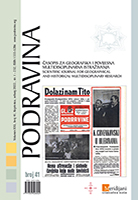- THE MEDIA ECHOES OF THE CROATIAN SPRING AND TITO'S VISIT TO KOPRIVNICA IN 1971: THE CLASH OF SUSRETI AND GLAS PODRAVINE
- SLOBODNA DALMACIJA U HRVATSKOM PROLJE?U
- IZME?U DEKLARACIJE I HRVATSKOG PROLJE?A: STATUS KULTURE U GLASU PODRAVINE
- KLJU?NI TRENUCI HRVATSKOG PROLJE?A U OGLEDALU LOKALNOG TISKA � NA PRIMJERU GLASA PODRAVINE, VARA�DINSKIH VIJESTI I KARLOVA?KOG TJEDNIKA
- ANALIZA MEDIJA U SLAVONIJI I BARANJI ZA VRIJEME I NAKON HRVATSKOG PROLJE?A
- O LUDBREGU I OBITELJI BATTHY�NY S POSEBNIM OSVRTOM NA ODNOS PREMA RELIKVIJI PRESVETE KRVI KRISTOVE (CCA 1696. � 1817.)
- USTA�KI LOGOR ?UR?EVAC U VRIJEME LOGORNIKA ?URE MATONI?KINA (1942. GODINE)
- PRI?A O �IVOTU PODRAVSKOG PRAVNIKA VINKA KOLARA
- HOW EFFICIENT ARE COUNTIES IN THE CROATIAN RIVER DRAVA BASIN REGION? REVIEWING DATA ENVELOPMENT ANALYSIS APPLICATIONS
- U?INCI HRVATSKOGA PROLJE?A NA POLITIKU I DRU�TVO U KOPRIVNICI
- PODRAVKA NA TR�I�TIMA S IZRA�ENOM EKONOMIJOM MANJINSKIH ETNI?KIH ZAJEDNICA
- KOMUNIKACIJSKE KOMPETENCIJE ODGOJITELJA U KOPRIVNI?KO-KRI�EVA?KOJ �UPANIJI
- PRIKAZI NOVIH KNJIGA, ?ASOPISA I ZNANSTVENIH SKUPOVA
THE MEDIA ECHOES OF THE CROATIAN SPRING AND TITO'S VISIT TO KOPRIVNICA IN 1971: THE CLASH OF SUSRETI AND GLAS PODRAVINE
The town and municipality of Koprivnica did not actively participate in the reformist movement of the Croatian Spring until April 1971. The local Communist Party organisation leadership were toeing the rigid dogmatic Party line, exercising complete control over the local weekly Glas Podravine and Radio Koprivnica. This partly changed with the visit of Savka Dab?evi?-Ku?ar to the the Podravka factory resulting in a telegram of support sent to the Croatian Spring leadership. These events coincided with the launch of the youth paper Susreti (�Meetings�). Although only three issues were printed, Susreti caused a stir in the Koprivnica public life by opening a number of political and social topics and ideological taboos, at times in direct conflict with the Party officials. Due to a turn of political events, Koprivnica was in September 1971 chosen as the central destination of President Tito�s tour of north-western Croatia, with the purpose of demonstrating that there was no �nationalism and chauvinism� in this area. The minutely organised event drew mass attendance, which for a time changed Tito�s view of the Croatian Spring activists. Still, just a few weeks later Koprivnica saw an open suppression of Susreti contributors, who ended up banished from the public life for a considerable length of time. At the meeting of the federal Party senior leadership held in Kara?or?evo, the most influential local Party functionary Pavle Ga�i eventually turned against the Croatian Spring activists, leading to a political and media upheaval in Koprivnica, which during the next few years lived through its �Years of Led.�
Izvorni znanstveni rad / Original scientific paper�eljko KRU�ELJ

